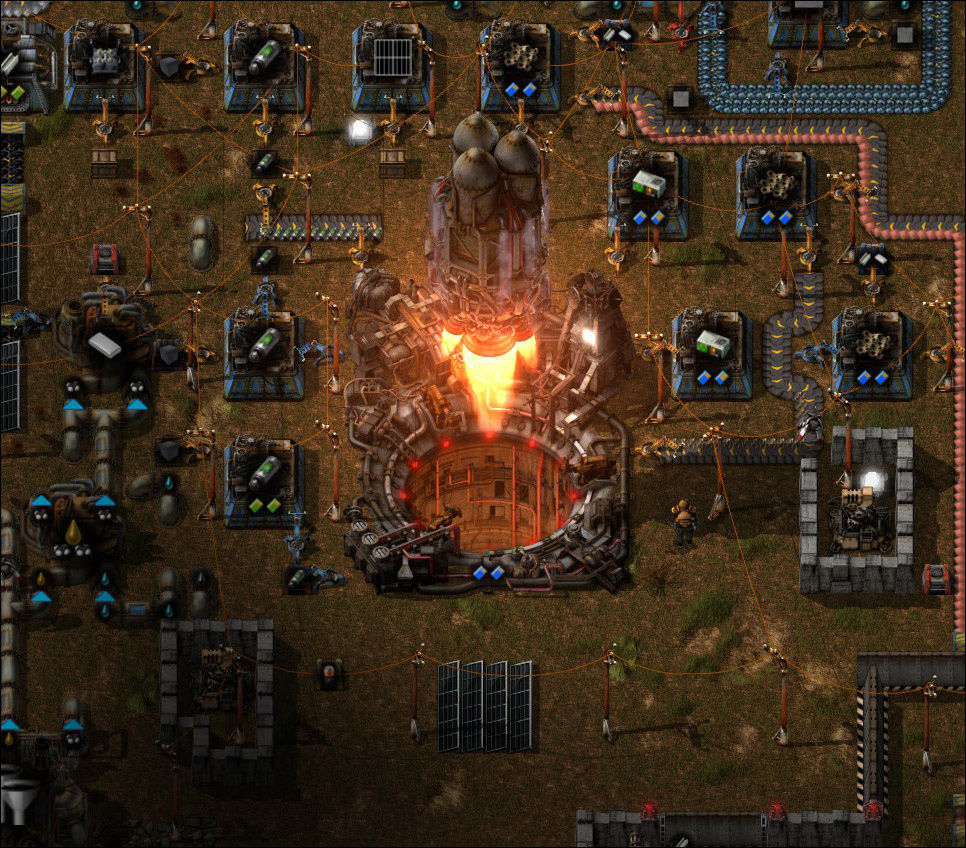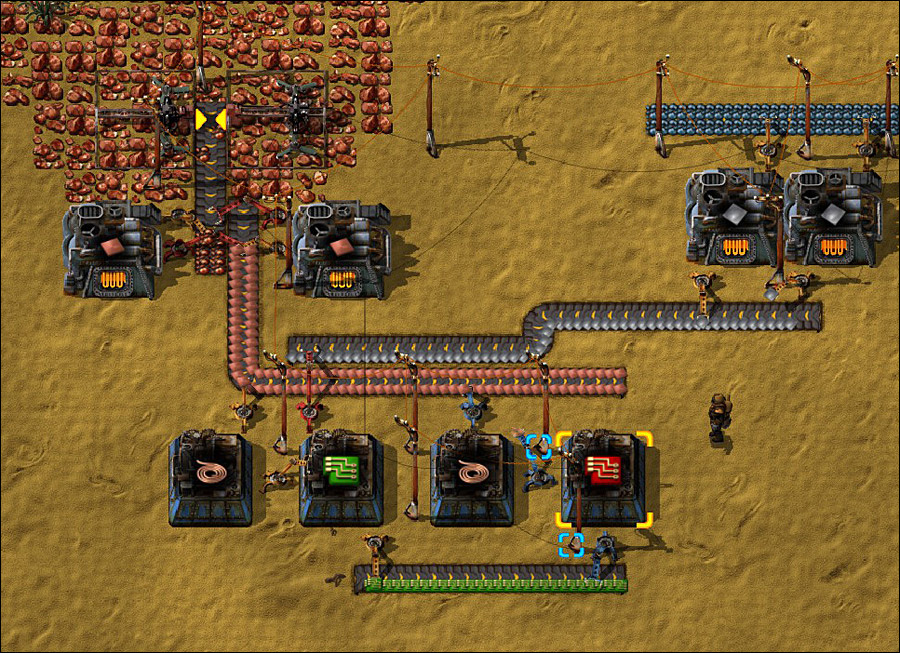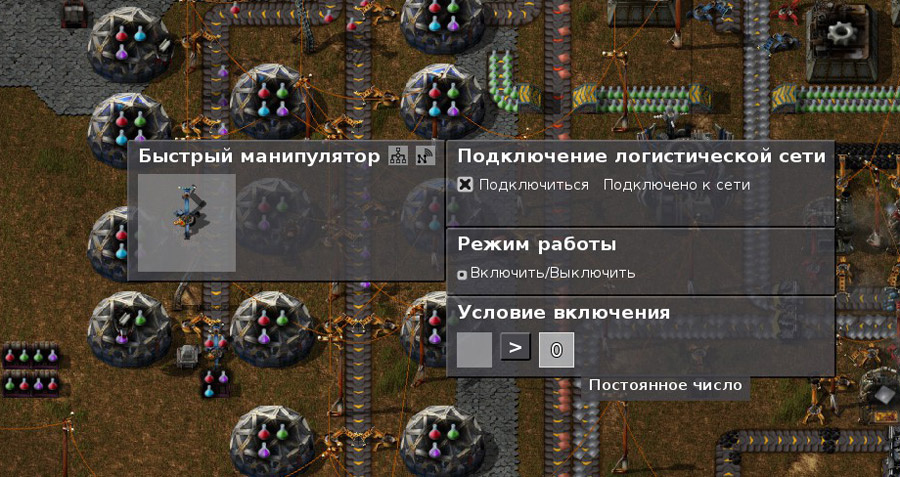Interesting Factorio Study: Plant Simulator
This game is another very interesting from the point of view of beta mechanics, representing at the same time a kind of programming language.

And here the funniest thing is the learning curve and interfaces. Let's take a look at these moments, good there are great finds.
')
You play as an engineer, waking up on an unfamiliar planet near the wreckage of his spaceship. Since you are an engineer, not an agronomist, instead of a space potato carto, you have to develop technology and assemble a rocket from scratch. In general, the good old game, described by Vernor Vinge - “restore civilization in the shortest possible time”.
The first task - using the technology of the Bronze Age, get pre-industrial, and then collect tin radar to find the main part of the ship. Then - get there on some kind of vehicle. They pick up the core of the computer and get access to all the data on how to properly make rockets, armor-piercing cartridges, space suits and other trifles important for survival.
The first thing that surprises you madly is that this is a strategy where the main character plays as a scroll. Seriously, your character in the center of the screen is always the focus of input, attention and interest. Instead of depersonalizing the game, you get an assembly workshop with inventory on legs. Engineer! How quickly it turns out, even our engineer can shoot. It turns out some hybrid Crimson Land (10%) and a simulator for the reconstruction of the domestic auto industry (90%).
So the essence. There are basic resources - coal, stone, copper, iron, water (later knowledge about oil and solar energy is added). The task is to assemble a rocket. Using only your hands at the start. Unlike conventional craft & explore games (the best example of relatively fresh - Radiation Island for tablets), here the main interest is shifted to conveyor production and automation of everything that your character cannot reach with his hands.
And so many resources are needed that he simply cannot do everything with his hands. Even to prepare an ordinary steel beam, you need to sweat very much - open the principles of steel processing, organize the smelting of metal, assemble the furnace, ensure the supply of fuel (that is, dig up the coal deposit) and so on.
Fortunately, our character does not sleep, does not eat anything, he quickly heals himself and is able to collect almost everything manually, including complex microcircuits. True - with linear velocity.
Then the first stage begins - you manually make some iron plates, bricks, and so on, and collect the first automated line that mines ore and digs coal. Plus, master the steam electric motor. At the exit from the first stage - a conveyor belt with iron plates, copper plates and a wire with a real current. From this, you can already collect anything.
The tree of science is huge:


Then you explore automation and start making lines for assembling various necessary pieces - conveyor belts, manipulators, assembly machines, scientific packages. In general, all-all. It looks like this. The figure is the simplest example:

The blue ribbon on the top is the incoming iron ore, which is placed with manipulators in a furnace, then melted into an iron plate. Then it is unloaded from the oven with manipulators to another tape. On the other hand, copper plates are suitable. The goal of the assembly etude is to get red chips. For the production of red chips need green chips, cable and steel plates. Cable needs copper. For the green chip, you need a cable and a steel plate. It's simple.
Of course, with legacy-driven design, the situation can be a bit more complicated:

By the time you need the force fields, the base will begin to take on this form:

By the way, pay attention. how everything smokes beautifully and pollutes the environment. The planet is inhabited (and not only by you), and the local nippers and spikers (functional names) do not like to smell your smoke. They come to bite and spit, respectively. Therefore, you still play with them in "kill them all and destroy their nests." Often it looks like this:

But right sketch of the last levels of Crimson:

The planet looks like this:

Red in the center - this is your base, polluting nature. Red clusters at the edges are the nests of the “zerg”, they must be weeded from time to time if the zerg climb to the base. From the edge of the desert, a mining outpost with oil is visible from above. In general, a distributed base and communications is one of the important facets of the game. For example, you can play Transport Tycoon:

Or build a network on flying drones:

One more thing that is important to us is the outfit of your spacesuit. Power shields, exoskeleton legs, batteries, dronstantion, night vision device, reactor, shoulder turret - a lot of things:

Once you are comfortable with this, the strangest part of the game begins. Namely - automation of automation or refactoring. It turns out that wild pleasure can deliver not only the “Hello, world!” Train that sizzles with brakes, not only a destroyed nest of clumps, but also how you redo all the processes so that they go without your participation.
In general, here it is necessary to distract a little and tell how the downtime of the game is distributed:
That is, you are playing in the development and support of a large project. True, individual. But the unforgettable feeling of debugging remains the whole game. So! You open wireless control networks and drones. And this changes a lot in the approach - if before that you had only the tools of cycles, now there are conditions. And with the development of building drones and blueprints, von Neumann’s almost complete machine was also.

And the base refactoring begins: to the hell out of non-renewable energy sources, the endless oil and the sun drives. To hell with bulky production lines, everything can be simplified. To hell overload and underload - now everything works like a clock. From this here the feeling "Works like a clock" can be dragged endlessly. It first appears during the unloading of an automatic train, and then appears with the development of a logical network.
The result of the game is the departing rocket. But the real joy - in the sandbox, which allows you to create any garbage, for example, music boxes. It was here that the guy resisted and “wrote” programmable speakers based on the combinators of a logical production network:
UPD: And graninas assembled a processor at all.
But the most interesting thing is the learning curve. To start playing "Factory" for the first time, you need to get a lot of information - from what and how it works to the base building templates. The question is solved ingeniously: you find someone else's base with two outposts, understand how it works, and fix it. At the same time, bury the fallen humanities colleagues who built it (in fact, no, they were eaten by pieces).
Each individual mission is short, has a specific goal and pleases with action - after the first campaign you want something else. And there are a number of logical tasks, a sandbox and everything.
In general, this is a very strange game. Strange that it is necessary to work and farm in it - but at the same time you play. Strange that it is necessary to debug processes: everything always goes wrong, but we must follow. But surprising because it shows how important complexity is: what you can do with your hands for an hour, is put on stream during the same time, and is done by thousands. And a coil is wound on top of this. And further. And further. Until all this will be difficult to cover consciously. In the process directly leads thought to the fact that robots should make other robots more difficult, and so on.
In general, another interesting training course. Which instead of traditional learning. At least in terms of circuit design, because the entire card is this board, and you trace on it with your own buildings and drawings of their sets like the “red chip production unit”.

And here the funniest thing is the learning curve and interfaces. Let's take a look at these moments, good there are great finds.
')
You play as an engineer, waking up on an unfamiliar planet near the wreckage of his spaceship. Since you are an engineer, not an agronomist, instead of a space potato carto, you have to develop technology and assemble a rocket from scratch. In general, the good old game, described by Vernor Vinge - “restore civilization in the shortest possible time”.
The first task - using the technology of the Bronze Age, get pre-industrial, and then collect tin radar to find the main part of the ship. Then - get there on some kind of vehicle. They pick up the core of the computer and get access to all the data on how to properly make rockets, armor-piercing cartridges, space suits and other trifles important for survival.
The first thing that surprises you madly is that this is a strategy where the main character plays as a scroll. Seriously, your character in the center of the screen is always the focus of input, attention and interest. Instead of depersonalizing the game, you get an assembly workshop with inventory on legs. Engineer! How quickly it turns out, even our engineer can shoot. It turns out some hybrid Crimson Land (10%) and a simulator for the reconstruction of the domestic auto industry (90%).
So the essence. There are basic resources - coal, stone, copper, iron, water (later knowledge about oil and solar energy is added). The task is to assemble a rocket. Using only your hands at the start. Unlike conventional craft & explore games (the best example of relatively fresh - Radiation Island for tablets), here the main interest is shifted to conveyor production and automation of everything that your character cannot reach with his hands.
And so many resources are needed that he simply cannot do everything with his hands. Even to prepare an ordinary steel beam, you need to sweat very much - open the principles of steel processing, organize the smelting of metal, assemble the furnace, ensure the supply of fuel (that is, dig up the coal deposit) and so on.
Fortunately, our character does not sleep, does not eat anything, he quickly heals himself and is able to collect almost everything manually, including complex microcircuits. True - with linear velocity.
Then the first stage begins - you manually make some iron plates, bricks, and so on, and collect the first automated line that mines ore and digs coal. Plus, master the steam electric motor. At the exit from the first stage - a conveyor belt with iron plates, copper plates and a wire with a real current. From this, you can already collect anything.
The tree of science is huge:


Then you explore automation and start making lines for assembling various necessary pieces - conveyor belts, manipulators, assembly machines, scientific packages. In general, all-all. It looks like this. The figure is the simplest example:

The blue ribbon on the top is the incoming iron ore, which is placed with manipulators in a furnace, then melted into an iron plate. Then it is unloaded from the oven with manipulators to another tape. On the other hand, copper plates are suitable. The goal of the assembly etude is to get red chips. For the production of red chips need green chips, cable and steel plates. Cable needs copper. For the green chip, you need a cable and a steel plate. It's simple.
Of course, with legacy-driven design, the situation can be a bit more complicated:

By the time you need the force fields, the base will begin to take on this form:

By the way, pay attention. how everything smokes beautifully and pollutes the environment. The planet is inhabited (and not only by you), and the local nippers and spikers (functional names) do not like to smell your smoke. They come to bite and spit, respectively. Therefore, you still play with them in "kill them all and destroy their nests." Often it looks like this:

But right sketch of the last levels of Crimson:

The planet looks like this:

Red in the center - this is your base, polluting nature. Red clusters at the edges are the nests of the “zerg”, they must be weeded from time to time if the zerg climb to the base. From the edge of the desert, a mining outpost with oil is visible from above. In general, a distributed base and communications is one of the important facets of the game. For example, you can play Transport Tycoon:

Or build a network on flying drones:

One more thing that is important to us is the outfit of your spacesuit. Power shields, exoskeleton legs, batteries, dronstantion, night vision device, reactor, shoulder turret - a lot of things:

Once you are comfortable with this, the strangest part of the game begins. Namely - automation of automation or refactoring. It turns out that wild pleasure can deliver not only the “Hello, world!” Train that sizzles with brakes, not only a destroyed nest of clumps, but also how you redo all the processes so that they go without your participation.
In general, here it is necessary to distract a little and tell how the downtime of the game is distributed:
- At the very beginning, you do everything with your hands, as in ordinary crafting games.
- In the middle, the speed of building the base is balanced with the speed of getting new toys from the auto labs, so there is something to do. If not, you can run through the bushes and shuffle into animals.
- In the later stages, it gets a bit boring, but if at least something goes wrong at least somewhere - you need to run and rule. And here is the question of what can go wrong. There are examples of the sea: the conveyor has become clogged and new nishtyaks do not climb on it, for some reason there is a delay with chips, the bites are gnawing at the radar, somewhere there are not enough blue science bags and we need to expand their production - and so on.
That is, you are playing in the development and support of a large project. True, individual. But the unforgettable feeling of debugging remains the whole game. So! You open wireless control networks and drones. And this changes a lot in the approach - if before that you had only the tools of cycles, now there are conditions. And with the development of building drones and blueprints, von Neumann’s almost complete machine was also.

And the base refactoring begins: to the hell out of non-renewable energy sources, the endless oil and the sun drives. To hell with bulky production lines, everything can be simplified. To hell overload and underload - now everything works like a clock. From this here the feeling "Works like a clock" can be dragged endlessly. It first appears during the unloading of an automatic train, and then appears with the development of a logical network.
The result of the game is the departing rocket. But the real joy - in the sandbox, which allows you to create any garbage, for example, music boxes. It was here that the guy resisted and “wrote” programmable speakers based on the combinators of a logical production network:
UPD: And graninas assembled a processor at all.
But the most interesting thing is the learning curve. To start playing "Factory" for the first time, you need to get a lot of information - from what and how it works to the base building templates. The question is solved ingeniously: you find someone else's base with two outposts, understand how it works, and fix it. At the same time, bury the fallen humanities colleagues who built it (in fact, no, they were eaten by pieces).
Each individual mission is short, has a specific goal and pleases with action - after the first campaign you want something else. And there are a number of logical tasks, a sandbox and everything.
In general, this is a very strange game. Strange that it is necessary to work and farm in it - but at the same time you play. Strange that it is necessary to debug processes: everything always goes wrong, but we must follow. But surprising because it shows how important complexity is: what you can do with your hands for an hour, is put on stream during the same time, and is done by thousands. And a coil is wound on top of this. And further. And further. Until all this will be difficult to cover consciously. In the process directly leads thought to the fact that robots should make other robots more difficult, and so on.
In general, another interesting training course. Which instead of traditional learning. At least in terms of circuit design, because the entire card is this board, and you trace on it with your own buildings and drawings of their sets like the “red chip production unit”.
Source: https://habr.com/ru/post/331800/
All Articles